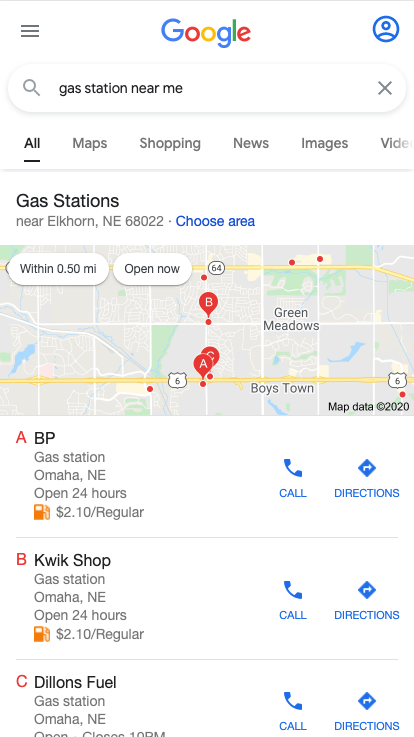Optimizing your business for local search is more important than ever, especially as more consumers are searching online for local services. Though the goal of local SEO is to increase online visibility within relevant searches with local intent, many businesses don’t understand what local search results look like in Google or even what ranking factors go into how Google shows results for “near me” searches.
Here’s what you need to know about local search results and how to rank well in them.
- What Do Local Search Results Look Like?
- What Doesn’t Have an Impact on Local SEO?
- Local Pack & Local Finder Ranking Factors
- Localized Organic Search Ranking Factors

What Do Local Search Results Look Like?
A local search engine results page, or SERP, consists of three parts: Map, Local Pack, and Organic Search Results. On both desktop and mobile, you’ll see the map, followed by a pack of three local businesses (with a Local Finder to view more), and then organic results that are relevant to the local intent of the search.


As you can see, appearing at the top of the local search results—particularly in the Local Pack—on Google can greatly increase your chances of better visibility, especially on mobile.
What Doesn’t Have an Impact on Local SEO?
There are many SEO myths out there about what does and doesn’t impact your local SEO rankings, and sifting through them all can be tough. To save you some time, here are a few factors that don’t directly impact your local SEO rankings:
- Keywords in Google My Business description
- Keywords in Google My Business services
- Participation in ad services
- Presence of appointment URL
While these don’t have an impact on your local search rank, they still can be helpful features and additions in reaching consumers looking for more information about your business in Google.
Local Pack & Local Finder Ranking Factors
When it comes to ranking well in Google local search results, the following are the most important factors:
- Google My Business
- Google My Business Categories
- Proximity of Address to Point of Search
- Physical Address in City of Search
- Reviews
- Links
Google My Business
The easiest and most impactful way to ensure online visibility at the exact moment your customers are searching is to create a Google My Business listing. Google My Business is a free service offered by Google that gives customers an easy way to find information about your business and connect with you by phone, messaging, or leaving reviews. Learn more about how to set up your Google My Business listing.
Google My Business Categories
When setting up your Google My Business listing, you need to pick relevant primary categories and secondary categories for your business. This helps Google understand what your business represents so it can effectively serve up your listing for relevant local search queries.
You can only select one primary category, but you can select up to nine secondary categories. Pick a primary category that represents your business as a whole and leave the other services that you offer for subcategories. Choosing a category that doesn’t fit your business services can have negative effects on your rankings along with conversion rates. Choosing the right category and secondary categories, however, can tremendously increase your visibility for local search queries.
Since Google often updates and adds new categories, make sure to review your categories a few times a year.
Proximity of Address to Point of Search
You might not be able to completely control this ranking signal, but it does play a role in determining which businesses show up in local search results. If a searcher is looking for services related to your business, and they’re searching from a nearby location, your business is more likely to show up. Conversely, if the searcher is closer to a competitor, the competitor is more likely to show up. This can change block by block.
Google understands that convenience is an important aspect of a consumer’s decision, especially if it’s for services like food or gas station nearby. One way to have some influence on this local ranking factor is to make sure you have consistent NAP (i.e., name, address, phone) data on your website and within your local business listings across all online business directories.
Physical Address in City of Search
Another impactful local ranking signal is your business location. Again, Google understands that convenience and proximity are factors consumers care about, so it pulls results based on location. Ensuring that your address is correct and consistently used in all local citations can increase the likelihood that your business appears in relevant, proximity-based results.
Another way you can improve visibility beyond your physical address in local business listings is on your website. You can optimize service keywords around location keywords—such as neighborhood names, major intersections, and other variants related to your service areas—which can help Google further understand where you’re trying to reach customers.
Reviews
Over the last few years, generating reviews has become a top local search ranking factor. Google (along with many other companies) now understand that reviews provide a timely representation for the credibility of a business. Reviews can have a considerable amount of influence on a customer’s perception and affect their chances of click-through or decision-making.
Work to create a review marketing strategy that can generate a continuous stream of new reviews for your local business that are positive and include relevant information about your services. Then, map out a plan for how you’ll respond to reviews. (Note: You should respond to both positive and negative reviews.) Learn more about how you can start generating more Google reviews for your business.
Links
Links are another way Google evaluates the authority and trust of your site. Different websites can have different domain authority and page authority scores, so make sure to find a link-worthy partner. Acquiring quality local links can be difficult to come by, but that only makes them that more valuable. Learn more about developing a quality backlink strategy.
Localized Organic Search Ranking Factors
Outside of the local search results that appear in the Map and Local Pack, you’ll want your business to show up in organic search results (i.e., non-paid results). Here are a few of the ranking factors in organic search:
- On-Page Content & Keyword Relevance
- Inbound Links & Anchor Text
- Mobile-Friendly Website & User Behavior
On-Page Content & Keyword Relevance
Completing keyword research and implementing those keywords into your website content should be at the top of your list when it comes to improving visibility in search engine results. Effective keyword research can help you identify the words and phrases searchers use to find local businesses or services, which, when utilized on your webpages, can help your website and its pages show up in results for relevant searches. Learn more about the importance of using targeted keyword research.
Inbound Links & Anchor Text
As noted above, links play a big role in where you rank in the Local Pack, and the same goes for organic search result listings. It’s safe to say earning links should make it to the top of your list. Apply the same local link building strategy for acquiring quality links and optimizing with relevant anchor text. By focusing on both the quality of links you’re receiving and the text that’s associated with it, search engines like Google have an easier time understanding the connection. With more signals showing relevance on your inbound links, the better your chances for gaining a little bit of ground in organic rankings.
Mobile-Friendly Website & User Behavior
Mobile internet usage is here to stay with 69% of all digital media time being spent on a mobile device. If you don’t have a mobile responsive website, this will hurt your visibility in local organic search results, as Google ranks websites with good user experience higher than those without.
Google has the capability to see how a user interacts with your site based on click-through rate (CTR) from a SERP to your webpage. If a user clicks on your businesses result and immediately bounces back to Google search results, Google then implies either this page is not relevant for this search query or the website did not help meet the users end goal. These type of user factors are less impactful in the giant scope of local ranking factors but that doesn’t mean they should be ignored.
Need help with local SEO? Hurrdat has local search optimization services that can help your small business improve online visibility. Sign up for our Local Search Fuel solution or contact us to learn more!



